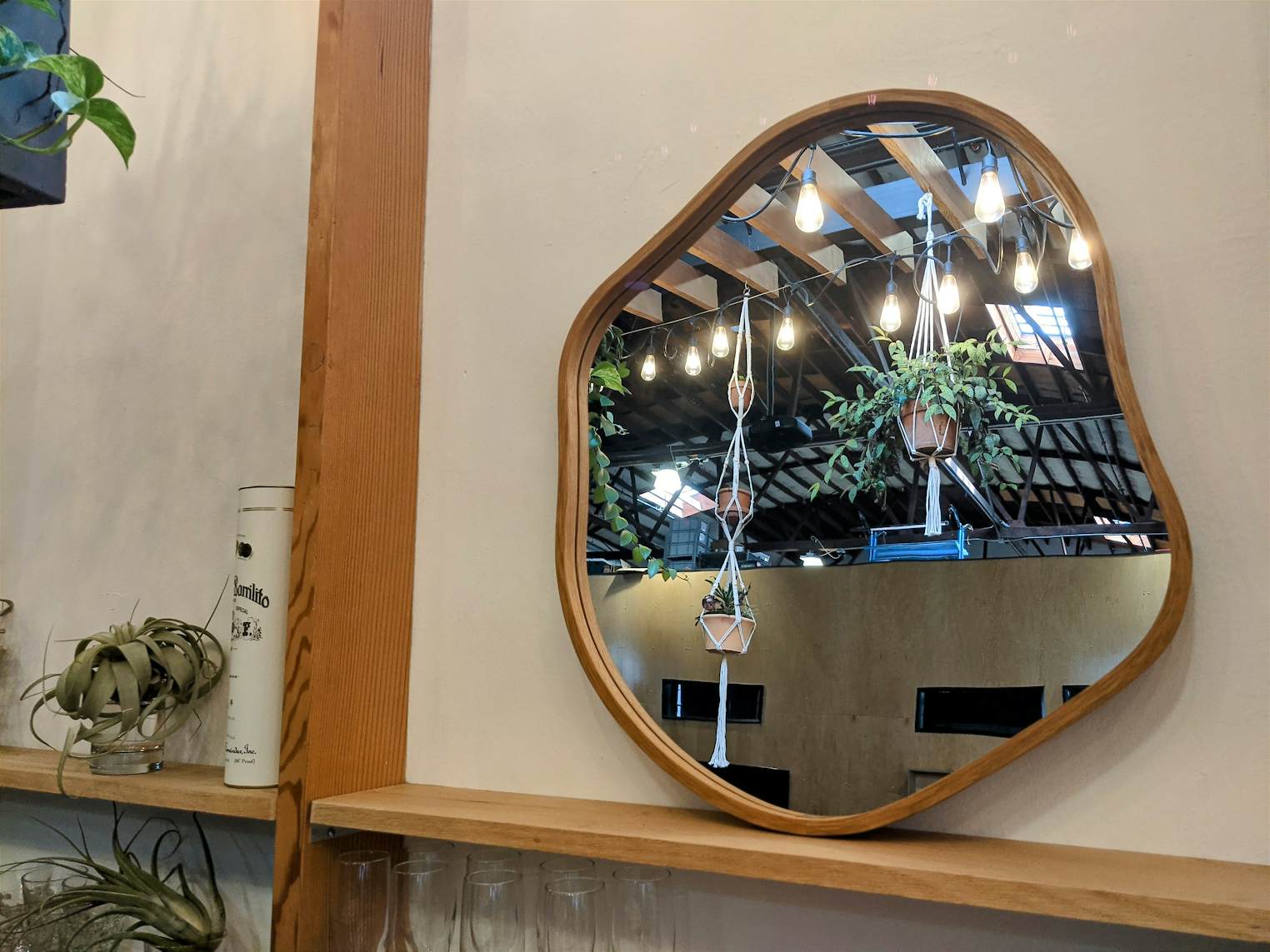Pond Mirror


A generatively designed mirror with a bent lamination frame.
44
Decor
Files Included (6)
50mm_joint.svg
1 kB90mm_joint.svg
1 kBBarbell.svg
935 BMirror_Template_1.svg
20 kBMirror_Template_2.svg
19 kBmirror.svg
24 kB
Materials
1/8" mirrored acrylic - (1) 24" x 36" sheet
1/8" hardboard - (1) 24" x 36" sheet
3/4" MDF - (6) 26" x 14" sheets
Hardwood for mirror frame - (16) 41" x 1.5" x 1/16" strips
Hardwood for barbell joinery - ~0.75" thick, enough for 4 small barbells, each 1.03" long
Double-sided tape
Packing tape
Shaper tape
Wood glue
DAP Weldwood plastic resin glue
Framer's points
Wood finish of your choice
Tools
Shaper Origin + Workstation
1/4" cutter
1/8" cutter
Router table
1/4" rabbeting cutter, such as Amana #49352
Clamps
Framer's point driver
Instructions
This project uses Origin to create a bending form in two halves based on a generative organic shape. After bending, the two halves of the frame are joined with barbells. Mirrored acrylic is cut to match and assembled into the frame. Step 1: Cut Mirror Select your mirror and backing material, laminate the two together, and cut to shape. I used 1/8" acrylic mirror and 1/8" hardboard backing, laminated with double-sided tape. You may cut with the outward-facing surface of the mirror facing up or down, but note that the cut file is not symmetric so pay attention to your preferred orientation and flip the cut file if necessary. Step 2: Cut MDF bending templates Each mirror half has its own bending template, and each of these templates consists of three parts - a rectangular base, and two matching curved patterns. Cut the rectangular bases using whatever method you're comfortable with. For the curved patterns, Origin files are attached. Each curved pattern includes clamp holes which are best cut in a drill press with a large Forstner bit, but these can also be cut with Origin if needed. Once all the parts are cut, glue each pair of matching curved pieces together, but do not glue these to the rectangular bases - you'll need to separate these parts to mount the templates to Workstation later. Cover the templates with packing tape to provide a nonstick glueup surface and clamp the templates to your workbench. Step 3: Bent lamination Apply plastic resin glue to a set of eight hardwood bending strips, then stack and align the strips. You'll notice that the bending templates each have a 50mm lead-in and 90mm lead-out zone - starting at the 50mm lead-in zone, clamp the strips to your template, being careful to keep the strips square to the base of the template. Step 4: Cleanup and thicknessing You'll have a bit of squeezeout from lamination, and the joinery files are set up for a 1.2" final part, so you'll need to clean up and thickness the laminated parts. I like to use a thickness sander for this, but there are a few ways to do it with other tools such as a table saw, router table, or hand plane. Step 5: Cut barbells Use the attached Origin files to cut the positive barbells first, setting up a small scrap of hardwood ~0.75" thick on the Workstation shelf. These will be used to tune the fit of the negative barbell in the mirror frame. I cut the barbells to 0.625" depth, then resawed my stock on the bandsaw to release the parts - this prevents small parts breaking loose while cutting with Origin. The barbells are a bit shorter in length than the negative joinery in order to pull the two halves of the mirror frame together, and the outer profile should fit snugly. The setup for the mirror frame is a bit more complicated. Use double-sided tape to reattach the laminated part to its corresponding template, being careful to keep the part square to the template. Then use the vertical alignment pins to locate the template to Workstation's front datum and clamp in place. For each joint, first you'll trim to length, then you'll cut the negative barbell, tuning the fit using the positives. Step 6: Joinery glueup Apply wood glue to the joinery, press into place, and let cure. Sand the joint smooth before continuing on. Step 7: Rabbet Rabbet the back of the mirror frame to accept the mirror. I did this on the router table with a 1/4" rabbeting cutter, to half the thickness of the frame (0.6"). This cuts the frame to match the mirror profile and leaves a bit of room in the back for wall hanging hardware. Step 8: Finish and assemble. Finish the frame without the mirror installed. Once you are satisfied with the finish, drop the mirror in and tack it in place with framer's points. Step 9: Set on a shelf or hang on the wall Self explanatory. Your mirror is done! Enjoy.







